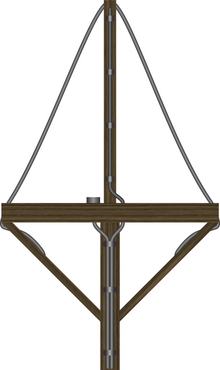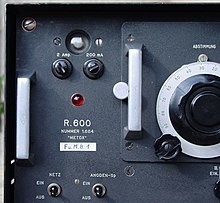Metox
Metox was the name of the radio measurement observation device FuMB 1 of the Kriegsmarine . The device was manufactured by the Parisian companies Metox and Grandin. This radar warning device was used from 1940 on surface units and from August 1942 on German submarines in order to be able to locate the radar waves emitted by ships, airplanes or land stations . The origin of the signal (friend / foe) could not be determined.
Operation history and technical data
receiver
The Metox device R203 was intended for use by the Air Force and worked on the wavelength range 1.88 m to 5 m.
The Metox receiver R600 worked in the meter wave band (0.62 m to 2.65 m wavelength, 113 MHz to 484 MHz frequency, today's ultra-short wave range ) as a heterodyne receiver . It issued an acoustic warning that was recorded by the listener via headphones or connected to the on-board loudspeaker system. The R600 became known in specialist circles for its typical Lecher input circuit. This emerged from the Lecher line , which was curved into a circular shape and thus made usable for operation using a rotary knob.
The improved Metox R600A came into use from February 1943. In addition, at the suggestion of a radio operator, an additional cathode ray tube from another radio receiver was connected as a visual display, called the magic eye , in order to make "inaudible" frequency ranges visible (BdU KTB of March 6, 1943).
In use, the entire wavelength range was always searched on the scale with the help of a rotary knob. If a signal was detected, the scale value could be translated into the associated wavelength or frequency using a table. If the frequency was known, the transmitter could be identified.
Biscay Cross

The first makeshift dipole antenna consisted of a simple wooden cross to which two dipoles (horizontally and vertically polarized) were attached. The official name was FuMBAnt 2 Honduras . Colloquially it was called the Southern Cross or the Biscay Cross .
This antenna was attached to the front periscope bracket with a clamp and had to be turned by 90 ° by hand at short intervals by one of the sea guards. By means of the rotation, the rough direction of ± 45 ° from which a radar was transmitting could be determined. This was considered sufficient, since the Metox was only intended to warn of radar and to enable the submarine to escape a possible subsequent attack by diving. Before the submarine could dive, however, the antenna cable to the Metox receiver first had to be pulled in through the open tower hatch and the antenna dismantled and brought into the interior of the boat. The wavelength range was 1.2 m to 4 m (80 MHz to 250 MHz).
In the combination of Metox and Biskaya Cross, a wavelength range from 1.2 m to 2.65 m could be covered. This enabled the British radar systems ASV MkI (1.5 m) and ASV MkII (1.7 m), which were used on the aircraft of the British Coastal Command, to be recorded. There were also warnings about the sea-based British radars of the types 286/290/291, which operated on 1.4 m wavelength and which had been in use since the end of 1940.
A safe range at sea was 6 to 7 nautical miles (11 to 13 km). The maximum range is said to have been around 10 nautical miles (18 km). The range mainly depended on the strength of the station. A stationary air force transmitter near Bordeaux was located at a distance of 80 km, a powerful transmitter near Cap Ivi (Mediterranean Sea) up to 60 nautical miles (110 km).
Bali antenna
After a number of experiments with different antennas to replace the Biscay Cross, a new pressure-resistant and permanently installed antenna finally was installed from March 1943 FuMBAnt3 Bali I . The seafarers colloquially called this antenna a bunny .
This round dipole antenna consisted of two round rods that were arranged one below the other and sheathed with wire mesh, as well as of two vertical, opposite rods that were placed on top. Their wavelength range was 75 cm to 300 cm (100 MHz to 400 MHz). A directional determination was not possible with this antenna; The range of the combination Metox and Bali is said to have been significantly greater than with the Biscay cross.
Allied countermeasures
The device was used with good success until March 1943, but then it failed more and more often because the British aircraft received a new location system, the ASV Mk III radar, which worked on the decimeter wave . The magic eye was of no use against this either. The decimeter radar had been in use for some time on Allied warships.
On the German side, this led to the false conclusion that the opposite side could absorb the impulses emitted by the device itself (natural radiation). A self-test with an air force machine that was able to locate the radiation from the Metox at a distance of up to 70 km apparently confirmed this assumption. The BdU therefore banned the use of the devices on July 31, 1943.
Further developments
As a result, further devices in the meter range were developed (FuMB 8 C Cyprus I, FuMB 9 C Cyprus II, FuMB 10 Borkum), which, at the expense of the range, were better and better shielded and therefore radiated less and less. None of them responded to the radar devices in the decimeter range (around 10 cm) now frequently used by the Allies.
Only the FuMB 7 Naxos device , which covered the decimeter wave range by 8 cm to 12 cm and was introduced in October 1943, improved the position of the submarines again.
See also
literature
- Arthur O. Bauer: Radio direction finding as an Allied weapon against German submarines 1939-1945. How weaknesses and failures in the radio control of the submarines contributed to the outcome of the “Battle of the Atlantic”. Arthur O. Bauer Selbstverlag, Diemen , The Netherlands 1997, p. 198, ISBN 3-00-002142-6 .
- Brian Johnson: Top Secret - Science and Technology in World War II . Motorbuch-Verlag, Stuttgart 1983, ISBN 9783879438167 .
- Brennecke, Jochen: The turning point in the submarine war. Causes and consequences 1939-1943 . Köhlers Verlags-Ges. 1984. ISBN 9783782202817
- Fritz Trenkle : The German radio measurement methods until 1945 . Motorbuch-Verlag, Stuttgart 1979.
Web links
- Lecture by Chef N Wa I on March 10, 1944 to the “Locating Devices” working group (PDF; 1.3 MB)
- Overview of radar detectors of the Kriegsmarine (English)
- BdU War Diary (KTB) - English translation
- Submarine document archive (English, partly German original documents)
- The Metox Affair
- M.Dv.291 Radio Measurement Equipment Customer (pdf)





